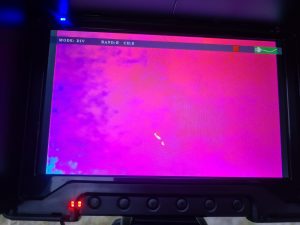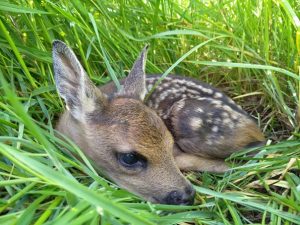What does the digitalsee employee, a drone pilot by profession, do on his day off or even before he starts work at 4.30 a.m. in May and June? That's right, saving fawns!
Every year many little fawns fall victim to a mower. I would like to spare you the unattractive photos here!
Modern technology makes it possible to do something about it. Many multicopter pilots, who also have a system with a thermal imaging camera, are organising themselves, sometimes together with the nature conservation organisation NABU, to help farmers and hunters to scan the areas to be mown from the air in advance and to spare the animals this agonising death.

The prerequisite for this is in any case a multicopter with a thermal imaging camera. There are different systems from different manufacturers in several price ranges. They start at around €2,500. However, with many systems in the lower price range, the resolution of the thermal imaging camera is very coarse, which makes a lower flight altitude necessary. This in turn increases the risk of collision with trees at the edge of the field and reduces the area coverage.
But that is not enough. Additional material is needed, such as more batteries for the multicopter, an additional monitor, handheld radios for coordination, and possibly a tripod and transport baskets.
Depending on the area of use, an A2 remote pilot certificate from the German Federal Aviation Authority may also be required, which can be obtained through a course with two multiple-choice examinations conducted by certified bodies and for which a fee is charged.
At the field, the pilot meets the farmer/hunter and 2-3 other helpers (or more if the field is large) at the field to be mown before sunrise and flies over it systematically. Identified heat sources in the field are checked by the teams of helpers. If fawns are found here, there are two possible procedures:
- The fawn is taken out of the danger zone, e.g. to a neighbouring field, by the helpers wearing gloves and with lots of grass between them in transport baskets.
- The fawn is covered with a basket and secured to the ground with pegs and marked with a grazing stick or similar. In this case, the farmer mows around it and then removes the basket.
The areas to be searched are always different in size, always offer a different number of finds and also always have surprises 😊
As a reward for getting up early and all the equipment, there are pictures like these:

Photo: Joachim Neumann, NABU Species Conservation Centre Leiferde/Gifhorn
Via an online platform, it is possible to connect all participants for such actions. Farmers and hunters enter the areas either on www.rehkitzretter.eu or in the UAV Editor or approach one of us directly. We then coordinate the operations among ourselves in order to optimise the areas and resources.
I am a member of a group of currently 7 pilots who are active in the district of Peine, the district of Hildesheim, Wolfenbüttel, Salzgitter, Braunschweig, Gifhorn and partly in the Hannover region. The large catchment area with comparatively few pilots makes it not always easy to get everything under one hat.
Therefore, we are always happy to receive active support and to expand our network!
If you have any questions, please contact me (adrian.richter@digitalsee.de).
Blog post: @Adrian R.

